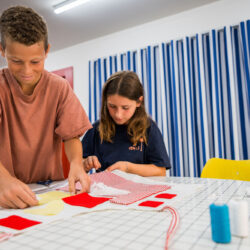Behind the MoMu scenes: What happened to the MoMu collection?

Until 2021 MoMu temporarily closes its doors for a thorough renovation. What happens in the meantime behinds the scenes of the museum, with its impressive collection?
32.000 pieces. 400 made-to-order moving boxes. Twenty-eight truckloads. Five days of moving. Three destinations. No effort was spared in the relocation of MoMu’s collection, housed safely under the museum’s roof since its opening in 2002. Following plans for a total renovation of its homebase in the Nationalestraat this treasured collection embarked on a once-in-a lifetime journey, with the prospect of a new place to call home. The moving process of the collection presented a daunting task to MoMu’s collections team, but at the same time offered a set of unique opportunities to ensure an exciting future for the biggest collection of Belgian fashion in the world.

past
MoMu was one step ahead of the game. In 2011, the museum was already forced to rethink its storage possibilities. An external warehouse in the Port of Antwerp was thus rented in order to accommodate its predecessor’s (Vrieselhofmuseum) artisanal textile tools’ collection. Over the coming yearsit was joined by MoMu’s extant collection of historical dress. This alleviated the pressure on the in-house storage rooms, which only a decade after the museum’s opening had started to - almost literally - burst at the seams.

This was only a tip of the iceberg, and as the museum’s grand renovation approached, over circa 20.000 objects still had to be relocated. When planning the move, the collections team started from one question: “How can we make this process as comfortable as humanly possible?”. An important step herein was the design, testing and production of 400 made-to-order polypropylene moving boxes in which the delicate garments could be safely transported. Other preparatory tasks included photographing formerly undocumented pieces, as well as checking inventory numbers. Collection’s curator Wim Mertens remarks that a lot of this behind-the-scenes work goes unnoticed.
There are a lot of things people don’t realise. For example, many objects receive a made-to-measure support to protect them from falling over and losing shape .
Over the course of spring 2018 - one and a half years after packing had started - MoMu waved its collection goodbye, as it was distributed across storage rooms in Antwerp, Mechelen and The Hague.

present
Life goes on. Work behind the scenes of the museum has not changed that much.
Beside managing a constant influx of new acquisitions - around 300 on a yearly basis - the team is constantly preoccupied with the daily task of managing the collection. A start is made to relocate redundant objects, others are re-packed for instance. Other tasks include preparing the museum’s first permanent exhibition - with trial set-ups and photoshoots for MoMu’s collection book - starting in the summer of 2019 - and various administrative and research projects.

future
What does the future hold? By winter 2019, the construction of a brand-new external storage - to be shared with fellow museums FoMu and DIVA - is expected to be be finished. After one final move from its temporary locations, the collection will be reunited under the same roof for the first time since 2012. From this moment onward, loans will again be granted to museums across the globe. What might seem a rather trivial task, is actually a very time-consuming task with an even more important function.
A loan is so much more than placing an object somewhere else. Loans reinforce bonds between musea, between collections,…. What is more, they are a chance for MoMu to make a name outside of its own walls, and to grow internationally. When a museum wishes to set up an exhibition around an Antwerp designer, they immediately look at MoMu as a point of contact for both knowledge and a collection from which they can lend pieces.
A portion of the collection - comprised of garments made of plastics - will move back to the newly renovated museum, where it will be placed in a smaller, specialized in-house storage from where its delicate conservation process will be closely monitored and studied. Other garments will be placed in the museum’s permanent exhibition, or will be taken out of the archives for certain periods of time to feature in temporary exhibitions - in Antwerp, or far beyond.



